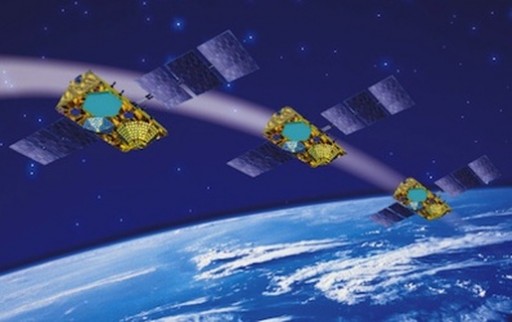Globalstar Second Generation

Globalstar’s second generation of low-orbiting communication satellites are manufactured by Thales Alenia Space of Italy and are Operated by Globalstar Inc., Covington, Louisiana, USA. Globalstar is a LEO satellite constellation that is similar to the Iridium and Orbcomm Satellite Communication systems. The company provides mobile and fixed satellite telephone communications, simplex and duplex data communications and satellite airtime packages.
The individual satellites are based on Thales Alenia’s Proteus satellite bus in a modified form allowing it to carry more powerful communication payloads. It is trapezoidal in shape, consisting of rigid aluminum honeycomb panels. The satellite is equipped with two deployable, three segment solar arrays and onboard batteries for power supply. The solar arrays are capable of automatic sun-tracking to increase exposure. Beginning of life power is 2,400 watts and EOL (End Of Life) power is about 1,700 watts.
The communication antennas are mounted on the larger of the rectangular panels of the satellite that faces the Earth. Globalstar-2 is equipped with 16 C- to S-Band transponders for communications with Globalstar Gateways, and 16 L- to C-Band transponders for communications with user terminals. The Earth-facing deck is pointed correctly by three-axis-stabilization with attitude data being supplied by Earth and Sun-Sensors and a magnetic sensor. In addition to three-axis-stabilization, the satellite features a Hydrazine monopropellant propulsion system for orbit adjustments and phasing. Each of the satellites features redundant systems to prevent single-point failures from causing the loss of a spacecraft. Globalstar-2 satellites have a liftoff mass of 700 Kilograms and a design life of 15 years.
The Globalstar constellation operates from a circular orbit at 1,410 Kilometers with and inclination of 52 degrees. Soyuz/Fregat delivers them to a 920-Kilometer phasing orbit from where the satellites use their own propulsion system to enter the correct positions in the constellation 500 Kilometers up.
With its satellite constellation, Globalstar serves more than 400,000 subscribers in more than 120 countries. Global customer segments of Globalstar include: oil and gas, government, mining, military, transportation, heavy construction, emergency preparedness & response, business continuity and individual users.
